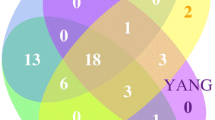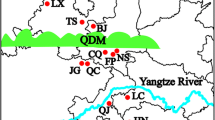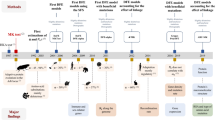Abstract
In order to assess the roles of gene conversion followed by natural selection and balancing selection for point mutations in polymorphisms at major histocompatibility complex (MHC) loci, DNA sequences of several mammalian taxa were analyzed. Synonymous and nonsynonymous diversities were estimated separately for the antigen recognition site (ARS) and the remaining region of class I and class II genes. In some sequence pairs, the number of nonsynonymous substitutions exceeds that of synonymous substitutions at the ARS. This result indicates that some kind of balancing selection for point mutation is operating. In other sequence pairs (particularly of bovine and of rabbit), the number of synonymous substitutions at the ARS exceeds the same number at the remaining region. This result indicates that gene conversion involving a short region followed by natural selection is important. In general, a combination of gene conversion, point mutation, natural selection and random drift is thought to have contributed to polymorphisms.
Similar content being viewed by others
References
Basten CJ, Ohta T (1992) Simulation study of a multigene family, with special reference to the evolution of compensatory advantageous mutations. Genetics 132:247–252
Bjorkman PJ, Saper MA, Samraoui B, Bennett WS, Strominger JL, Wiley DC (1987) Structure of the human class I histocompatibility antigen, HLA-A2. Nature 329:506–512
Brown JH, Jardetzky TS, Gorga JC, Stern LJ, Urban RG, Strominger JL, Wiley DC (1993) Three-dimensional structure of the human class II histocompatibility antigen HLA-DR1. Nature 364:33–39
Fitch DHA, Bailey WJ, Tagle DA, Goodman M, Sieu L, Slightom JL (1991) Duplication of the γ-globin gene mediated by repetitive L1 LINE sequences in an early ancestor of simian primates. Proc Natl Acad Sci USA 88:7396–7400
Hedrick PW (1994) Evolutionary genetics of the major histocompatibility complex. Am Naturalist 143:945–964
Hughes AL, Nei M (1988) Pattern of nucleotide substitution at major histocompatibility complex class I loci reveals overdominant selection. Nature 335:167–170
Hughes AL, Nei M (1989) Nucleotide substitution at major histocompatibility complex class I1 loci: evidence for overdominant selection. Proc Natl Acad Sci USA 86:958–962
Ina Y (1992) ODEN. National Institute of Genetics, Mishima, Japan
Ina Y (1995) New methods for estimating the numbers of synonymous and nonsynonymous substitutions. J Mol Evol 40:190–226
Ina Y, Gojobori T (1994) Statistical analysis of nucleotide sequences of the hemagglutinin gene of human influenza A viruses. Proc Natl Acad Sci USA 91:8388–8392
Irwin DM, Wilson AC (1990) Concerted evolution of ruminant stomach lysozymes. J Biol Chem 265:4944–4952
Kappes D, Strominger JL (1988) Human class 11 major histocompatibility complex genes and proteins. Annu Rev Biochem 57:991–1028
Kimura M (1980) A simple method for estimating evolutionary rate of base substitutions through comparative studies of nucleotide sequences. J Mol Evol 16:111–120
Lawlor DA, Zemmour J, Ennis PD, Parham P (1990) Evolution of class-I MHC genes and proteins: from natural selection to thymic selection. Annu Rev Immunol 8:23–63
Nei M, Gojobori T (1986) Simple methods for estimating the numbers of synonymous and nonsynonymous nucleotide substitutions. Mol Biol Evol 3:418–426
Ogawa T, Kitajima M, Nakashima K, Sakaki Y, Ohno M (1995) Molecular evolution of group II phospholipases A2. J Mol Evol (in press)
Ohta T (1991) Role of diversifying selection and gene conversion in evolution of major histocompatibility complex loci. Proc Natl Acad Sci USA 88:6716–6720
Ohta T (1992) A statistical examination of hypervariability in complementarity determining regions of immunoglobulins. Mol Phyl Evol 1:305–311
Ohta T (1994) On hypervariability at the reactive center of proteolytic enzymes and their inhibitors. J Mol Evol 39:614–619
Ohta T, Basten CJ (1992) Gene conversion generates hypervariability at the variable regions of kallikreins and their inhibitors. Mol Phyl Evol 1:87–90
Riley MA (1993) Positive selection for colicin diversity in bacteria. Mol Biol Evol 10:1048–1059.
Author information
Authors and Affiliations
Rights and permissions
About this article
Cite this article
Ohta, T. Gene conversion vs point mutation in generating variability at the antigen recognition site of major histocompatibility complex loci. J Mol Evol 41, 115–119 (1995). https://doi.org/10.1007/BF00170662
Received:
Accepted:
Issue Date:
DOI: https://doi.org/10.1007/BF00170662




